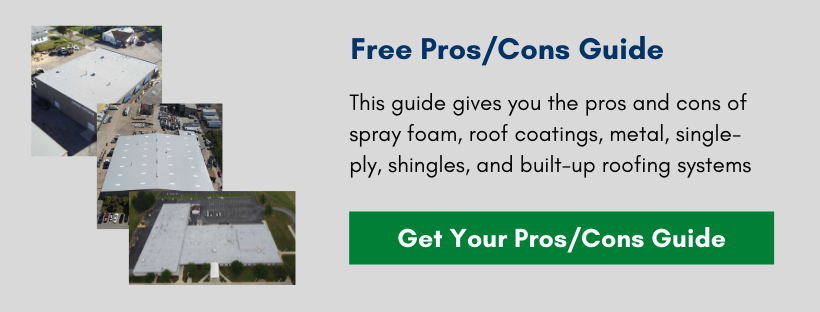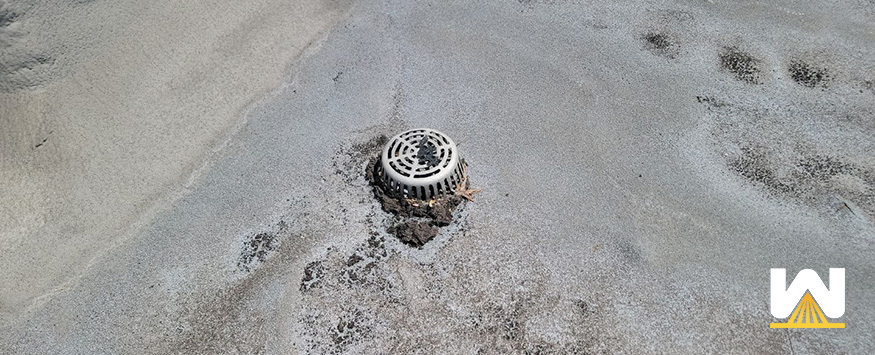If you’re reading this post, you truly are like no other.
A commercial roof is out-of-sight, out-of-mind to most. The only trigger that creates any action is when the roof leaks.
But not you.
You’re smart!
You know that preventative maintenance:
- makes the roof last longer
- keeps the warranty active
- and lowers the lifetime cost of the roof
Just like your car you get oil changes in. What would happen if you never got an oil change in 5 years. Bad things would happen.
A commercial roof is no different.
In this article, you’ll learn everything you need to know about preventative maintenance, such as:
- Why do building owners sign up for it?
- How much does it cost?
- What consequences are there if you don’t have a maintenance plan?
- What does a contractor actually do on a maintenance call?
- Can you do the maintenance yourself?
- Do you need a maintenance plan to keep your warranty active?
- What’s the cost of doing maintenance for 10 years versus doing nothing?
And just so you’re aware, West Roofing Systems has been in commercial roofing since 1979. There are roofs we see every Spring and Fall for 20+ years. Maybe even longer than that.
This article has been read, edited, and approved for publication by one of West Roofing Systems’ owners, who has over 30 years of roofing experience.
Let’s get started!
Why do building owners sign up for preventative maintenance?
The first reason is to ensure a leak-free roof. Some companies have valuable assets inside the building that ABSOLUTELY cannot get wet.
For example, a grocery store cannot have water enter the building as it contaminates the food.
Any building that contains someone else’s assets, like a warehouse, cannot afford to have any leaks.
Having a professional on your roof in the Spring and Fall prepares and ensures the roof will last through the following season.
Keeping an eye on your roof prevents small repairs from turning into large ones. For example, on a TPO roof, the membrane may be losing adhesion to the insulation below. A contractor can repair the adhesion. Ignoring the issue would only allow the lost adhesion to get worse and eventually allow water to ruin the insulation (and possibly enter the building).
The same thing can happen on a metal roof.
Say a fastener is loose or has backed out. The contractor can see this and make the simple repair. If this repair wasn’t made, every rainfall would bring water under the roof, causing expensive repairs in the future.
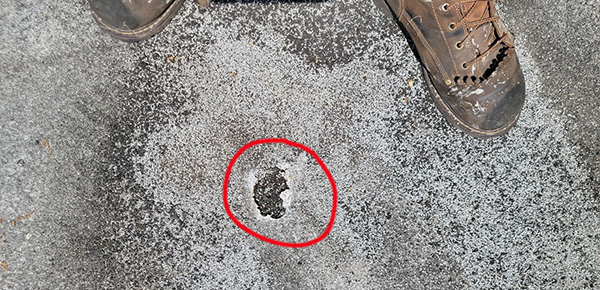
How much does preventive maintenance cost?
Preventative maintenance usually costs around 5-9 cents per square foot. There are many variables that influence cost:
- Location. How far away is the building from the roofing contractor?
- Number of trees. Trees have branches that damage membranes and also have leaves that constantly clog drains and gutters.
- Roof size. How long will it take a professional roofer to walk the roof and ensure everything is in working order? A 1000 sq. ft. roof will take less time to walk than a 100,000 sq. ft. roof.
What consequences are there if you don’t have a maintenance plan?
There are a few.
The first is if you have a warranty on the roofing system, it can be voided if routine maintenance isn’t kept.
For example, the roof leaks, you make a warranty claim, but half the roof is underwater because the drains are clogged.
Warranty claims on commercial roofs are similar to those with cars. If you never changed the oil and the motor blew up, would you expect those repairs to be covered?
The second consequence is that the roof won’t be prepared for the following season. For example, in the Fall, if there are any openings in the membrane (even the tiniest opening ever), water will get in and freeze over the Winter.
Once it thaws, then freezes and thaws again, the opening will be larger than before, allowing more water to enter.
Minor and simple repairs turn into more extensive, more expensive repairs. That’s the name of the game with preventative maintenance.
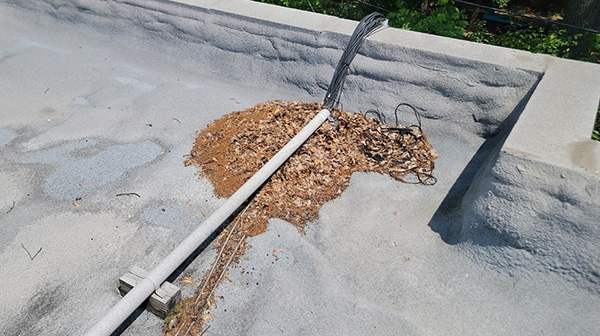
What does a contractor actually do on a maintenance call?
Here are the list of tasks that can occur on a maintenance call:
- Visual roof inspection
- Cleaning of drain covers and gutters
- Debris removal
- Small repairs completed
- All seams and flashings are inspected
- Computerized drawing of the roof
- Complete roof inspection report
Larger repairs, a new roof, or complete restoration options and costs can be included if necessary.
Can you do the maintenance yourself?
Yes.
Keep in mind that professional roofers are trained. They can tell when seams are losing adhesion, if the water on the roof is draining properly, and whether a fastener has been damaged or not.
These are just general things you might already know, but it’s peace of mind that someone specifically trained is up on your roof.
And it guarantees the warranty stays active.
And what about Fall Protection? Is your maintenance person trained in rooftop safety? If not, it’s a potential safety risk.
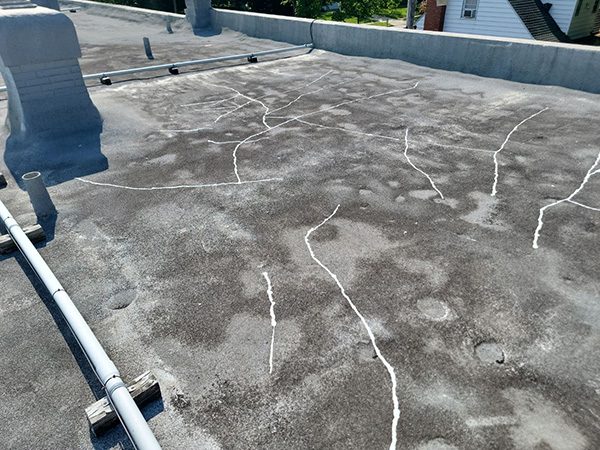
Do you need to have a maintenance plan to keep your warranty active?
Yes.
At least once per year, someone (whether that’s an employee or someone you’ve hired to perform preventative maintenance) will have to walk the roof, clean drains and gutters, identify areas prone to repair, and make a full inspection report.
What’s the cost of doing maintenance for 10 years versus doing nothing?
The size of the roof is important here. Let’s go through two scenarios, a 1,000 sq. ft. roof and a 100,000 sq. ft. roof.
| Scenario | Cost with Maintenance | Cost without Maintenance |
| 1,000 sq. ft. roof | ||
| Maintenance cost over 10 years | $1,400 | $0 |
| Cost of recoating in year 11 | $5,000 | N/A |
| Cost of replacement in year 11 | N/A | $10,000 |
| Total cost | $6,400 | $10,000 |
| 100,000 sq. ft. roof | ||
| Maintenance cost over 10 years | $140,000 | $0 |
| Cost of recoating in year 11 | $500,000 | N/A |
| Cost of replacement in year 11 | N/A | $1,000,000 |
| Total cost | $640,000 | $1,000,000 |
Key Points:
- Maintenance is typically performed twice a year, in Spring and Fall. (minimum 1x per year)
- Cost of maintenance: 7 cents per square foot per maintenance session.
- Cost of roof replacement: $10 per square foot.
- Cost of recoating: $5 per square foot.
- For both scenarios, maintenance shows significant cost savings over time.
- All costs are estimates. Many factors can influence cost.
Below is a breakdown of the numbers above if you’re interested:
1,000 square foot roof
For a 1000 sq. ft. roof, let’s say the cost of maintenance is 7 cents per square foot. And you do maintenance in the Spring and Fall.
1000 x 0.7 x 2 = $140 each year.
$140 for 10 years = $1,400.
100,000 square foot roof
For a 100,000 sq. ft. roof, let’s say the maintenance cost is also 7 cents per square foot. And you do maintenance in the Spring and Fall.
100000 x 0.7 x 2 = $14,000 each year.
$14,000 for 10 years = $140,000.
If you do nothing, there won’t be any cost. However, at this point (year 11) is when doing maintenance shows its cost-effectiveness.
If you don’t maintain your roof, it will likely need to be partially or completely torn off and replaced, which will cost, on average, $10 per square foot.
If you did maintain your roof, it will likely be eligible for restoration (through a roof coating system). This will likely cost, on average, $5 per square foot.
The total cost of a 1,000-square-foot roof with preventative maintenance and is recoated in year 11 = $1,400 + $5,000 = $6,400.
The same roof without maintenance but needs to be torn off and replaced = $10,000.
The total cost of a 100,000-square-foot roof with preventative maintenance and is recoated in year 11 = $140,000 + $500,000 = $640,000.
The same roof without maintenance but needs to be torn off and replaced = $1,000,000.
Conclusion
Hopefully, you’ve learned at least one new thing about preventative maintenance that you didn’t know before.
Here’s other content you might find helpful:
- What’s the ballpark cost of a roof coating system?
- VIDEO – The cost of a roof maintenance plan
- How to get an existing roof under a new warranty?
